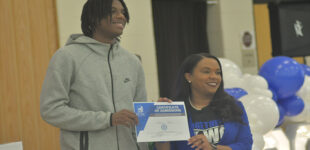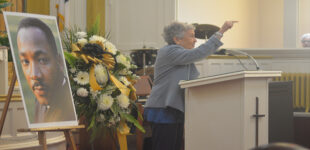Final grading decisions made by NCDPI and NCSBE

15% of students in WS/FCS will need methods to ‘catch up’
Last month Governor Roy Cooper announced that all North Carolina Schools will remain closed until the end of the school year. During his daily press conference to update citizens on the pandemic, Cooper said, “Classrooms may be closed but the learning is not over.
“We don’t make this decision lightly but it’s important to protect the health and safety of our students and our school staff.”
The announcement wasn’t a surprise to most, when considering the number of school days left in the 2019-2020 school year calendar, and the number of days students have already missed. The announcement did, however, force teachers and students to resume remote learning.
The N.C. State Board of Education defines remote learning as learning that takes place outside the traditional school setting using various media and formats. To help with remote learning locally, Winston-Salem/Forsyth County Schools distributed nearly 23,000 devices and more the 3,000 hotspots to make sure families have access to the Internet.
WS/FCS also held an informational seminar with teachers before remote learning started and there have been several “how to” videos created to help students, teachers and parents navigate software, as well as virtual tutoring sessions.
With all the changes that have occurred in education in recent weeks, school districts across the state and country have been tasked with making changes to the grading system as well. During the school board meeting last week, district leaders discussed how they plan to administer grades for the fourth quarter.
According to Nicolette Grant, WS/FCS chief academic officer, for the fourth quarter grading period, the focus will be essential learning necessary for students to be prepared for the next school year.
“Our team really sat down and went through our fourth quarter curriculum and recognizing the amount of time students were out of class, the normal traditional setting, and knowing what will be vitally important for them to be successful when they start the next school year. That is what the fourth quarter is focused on,” Grant said.
Before fourth quarter grades are submitted, students will have additional time to complete or re-do assignments. “We’re focusing on helping our students grow … this is not a time to penalize a student or give them a zero for not doing something,” Grant said.
Final grades for 2019-2020 school year will be based on decisions made by the N.C. Department of Public Instruction and the N.C. State Board of Education. Students in elementary school (K-5) will receive a narrative report card that will access the students’ strengths and areas for growth in math, English or ELA, science, and social studies. There will also be a general comment session for encore classes.
Instead of the normal “A”, “B” or “C,” students in middle school will see “PC19” or “WC19” on their final report cards which stands for pass and withdrawal. While students who receive WC19 will not receive credit for the course, according to district officials, it does not mean that a student has failed the course; instead it means they don’t have enough information to show “mastery.” Students who receive “WC19” will be given opportunities for credit recovery courses.
High school students in grades 9-11 will have the option to receive a PC19 or WC19 that will award credit for the course but will not count toward their GPA, or receive a numeric grade that will count toward their GPA. If a middle school student is taking a high school course, grading for that course will follow grading directions for high school courses. High school seniors will follow the PC19 or WC19 grading method.
While the district has tried to make “e-Learning” accessible for every student, thousands of students in the district haven’t even logged on to the system to complete assignments.
“We have approximately 5,000 who have not logged on to this magnificent platform that we’ve created,” Woodbury continued. “I think that the board and our community would like to hear what you’re doing to accommodate these students because according to the state board of education’s definition of remote learning, we still have to make sure that we consider learning as it relates to any issues at home that may be preventing them from learning.
“We have to figure out how to go beyond that challenge to reach out to all of our students to make sure they’re able to capitalize on this new way of learning.”
To try to address Woodbury’s concerns, Grant said district leaders have asked teachers to reach out to students to find out why they aren’t engaging and counselors and social workers will follow up to find out what barriers are preventing students from logging on.
“We’re asking the teachers first to reach out and see if students aren’t engaging, if they can find out why,” Grant continued. “Is it because of connectivity, which we do have hotspots we can provide? Is it because they need a device? We have devices we can provide. Is it because they aren’t feeling well or is there is sickness or illness in the family? Is it because the oldest student is trying to help they younger student and the older student can’t finish their work?”
During a virtual town hall meeting hosted by Action4Equity and Knollwood Baptist Church earlier the week, when discussing the students who haven’t completed E-Learning assignments, Superintendent Angela P. Hairston said a lot of the students who are not participating in E-Learning attend low performing schools. Hairston said the district will have to find ways to “catch students up” who have not completed assignments.
She mentioned several ideas that are currently being discussed to help students including Saturday school, after-school, and other methods. While there are federal dollars available for summer programs, most of those programs are virtual or a mix of virtual and face-to-face learning, so it won’t probably help the thousands of students who haven’t logged on.
“For 85% of our children, they are engaging in instruction just as we are engaging each other now. They are continuing their lessons and they are learning. For 15% of our children and mostly in our schools that are under-performing, children have not logged on, they’re not completing their packs of work, and so we will need to create some opportunities for children to catch up in the fall through Saturday school, after-school, intersessions.” Hairston continued. “There’s definitely going to have to be some time built in next year to compact what they should be learning and catch them up.”















